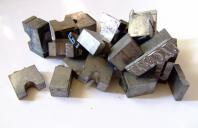An In-Depth Look at Lead and Its Effects on the Body
What is Lead?
Lead is number 82 in the periodic table and is classified as a "heavy metal." In its pure form, it is soft and malleable. It is a shiny silver-white when recently cut or melted but quickly turns dark gray after being exposed to air.
For thousands of years, lead was used in a variety of applications--pipes, paints, weights, alchemy, decorative objects, and cookware, just to name a few--because it was widespread and easy to work with, and occurred as a byproduct of smelting the rarer and more valuable silver and copper. It may have given ancient people a host of health problems! Today, it is still used in lead-acid batteries, bullets and shot, solders, and as a radiation shield.
How Lead Affects the Body
Lead can be swallowed, absorbed through the skin (dermal absorption), or inhaled, with the same negative effects on the body. Health effects from short-term overexposure (acute lead toxicity) include abdominal pain, constipation, tiredness, headaches, irritability, loss of appetite, memory loss, weakness, and pain and/or tingling in the hands and feet. The effects of long-term overexposure (chronic lead toxicity) include impotence, depression, forgetfulness, irritability, and nausea. Continued exposure can result in anemia, kidney and brain damage, and even death.
Babies and children in particular are very vulnerable to the effects of lead, due to their smaller body masses and still-developing bodies. Lead can cross the placental barrier, meaning that pregnant women who are exposed to lead also expose their unborn child(ren). Damage to the fetus' developing nervous system can lead to decreased IQ, attention deficit hyperactivity disorder (ADHD), and/or hearing impairment when the child is born and continuing into adulthood. Small children, who are prone to mouthing anything within reach and placing small objects in their mouths, are more at risk for exposure to lead, and very tiny amounts can cause permanent neurological and developmental problems.
Where Lead Shows Up
Lead was once regularly added to paint to improve its color, texture, and lifespan. The federal government banned it from use in homes in 1978, but any houses built before then likely still contain some lead paint. Care should be taken when renovating older houses and the resident should be alert for chipping or flaking paint. Lead is not prohibited in paint on commercial buildings.
Some painted glass or ceramics may contain lead. If properly glazed and/or fired the piece should be quite safe, but if the glaze becomes damaged or the piece was improperly fired, then the lead may migrate onto other surfaces. The Chanler Group's clients identified a great number of glass and ceramics with painted decorated exteriors that contained lead and worked hard to achieve reformulation across almost the entire industry.
Lead is used in ammunition (bullets and shot), batteries, and radiation shields, such as the ones doctors give patients to wear when they're taking x-rays. It is also used in machine parts, solder, and many types of art paints. People who work in occupations such as auto repair, painting, construction, and of course lead refineries and the like are therefore at higher risk for lead exposure and should take precautions.
Lead is used as a stabilizer in PVC, aka vinyl, which is used in hundreds of common consumer products, such as bags, toys, shoes, rain gear, inflatables, and product packaging. The Chanler Group's clients have found lead in lightbulbs, jumper cables, belts, hand tools, paper clips, and more. The PVC industry intends to discontinue the use of lead stabilizers by 2015.
How to Avoid Lead
If you're a California resident, look for a Proposition 65 warning. Manufacturers and retailers selling products in California must include a warning if their products contain lead, which is known to the State of California to cause cancer and reproductive harm.
You can also lower your risk of exposure to lead by avoiding vinyl products (carry an unlined cotton or nylon bag; buy curtains or bamboo blinds; use tools with wooden or hard plastic grips), glass or ceramics with painted decorations, and objects made from pewter or tin, which often contain lead. Wash hands frequently. Check websites such as saferproducts.gov to see if there have been any recent recalls or reports of lead in products.
The Chanler Group represents citizen enforcers who, acting in the public interest, enforce each citizen’s right to know when they are exposed to toxic chemicals found in consumer products sold in California and who hold companies accountable for unwarned exposures through imposition of civil penalties and injunctive relief, often requiring the removal of the offensive chemicals. Clients of The Chanler Group have issued dozens of Proposition 65 notices to manufacturers and retailers regarding the presence of toxic chemicals in their products that are sold in California without a warning.

